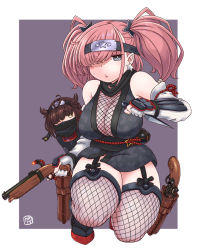

Edit | Leave a Comment | Favorite
User Comments:
jedi1357 commented at 2012-10-06 10:37:02 » #1175592
en.wikipedia.org/wiki/JNR_Class_C56
Artist's comment:
We went to the battlefield foals
◆1935 (10th year of Showa (Emperor Hirohito)) As a simple engine to maintain, the C56 line has been made into a compact and lightweight steam locomotive for the local line route.◆In military service it made a name for itself in the south, dodging the constant risk of derailment, relentless air raids and surviving --- along with the many soldiers they carried......Sisters in arms going to war with the men who depended on them. During the raids, their figure could be seen running around on the light-gauge rails of the local line earning these girls the popular nickname "Ponies of the Highland", theirs is a history of suffering that should not be forgotten in any way. ◆As workfellows of this legendary railway dropped into the foals like stones on a Go board they where compelled to reside with the Imperial Japanese Army on tracks laid down as transportation routes towards Thailand and Myanmar. I have tried to draw an image of that era's C56 railway.
[Translator note: I'm not really fluent in Japanese and usually only translate simple words so forgive me if I butchered this translation.]
 1 Points
1 Points
 Flag
Flag
en.wikipedia.org/wiki/JNR_Class_C56
Artist's comment:
戦場に行った仔馬達
◆1935(昭和10)年、ローカル線用に軽量小型で整備の簡単な機関車として、開発・製造されたのがC56形蒸気機関車です。 ◆その特長を軍部に買われての南方への出征、常に脱線の危険の付きまとう線路、絶え間ない空襲―――そして、多くの兵士と共に、次々と戦火に斃れていく姉妹達……後にSLブームの最中、ローカル線を軽快に走り回る姿から、「高原のポニー(仔馬)」として、親しまれた彼女達にも、決して忘れ去られてはならない苦難の歴史がありました。 ◆某所掲示板に投下してきた鉄道ネタメイドのお仲間として、ある住人の「」に描いて頂いた「ポニいさん」を元に、旧日本軍がタイ・ミャンマー方面の輸送路として敷設した、泰緬鉄道時代のC56達の姿を描いてみました。
◆1935(昭和10)年、ローカル線用に軽量小型で整備の簡単な機関車として、開発・製造されたのがC56形蒸気機関車です。 ◆その特長を軍部に買われての南方への出征、常に脱線の危険の付きまとう線路、絶え間ない空襲―――そして、多くの兵士と共に、次々と戦火に斃れていく姉妹達……後にSLブームの最中、ローカル線を軽快に走り回る姿から、「高原のポニー(仔馬)」として、親しまれた彼女達にも、決して忘れ去られてはならない苦難の歴史がありました。 ◆某所掲示板に投下してきた鉄道ネタメイドのお仲間として、ある住人の「」に描いて頂いた「ポニいさん」を元に、旧日本軍がタイ・ミャンマー方面の輸送路として敷設した、泰緬鉄道時代のC56達の姿を描いてみました。
We went to the battlefield foals
◆1935 (10th year of Showa (Emperor Hirohito)) As a simple engine to maintain, the C56 line has been made into a compact and lightweight steam locomotive for the local line route.◆In military service it made a name for itself in the south, dodging the constant risk of derailment, relentless air raids and surviving --- along with the many soldiers they carried......Sisters in arms going to war with the men who depended on them. During the raids, their figure could be seen running around on the light-gauge rails of the local line earning these girls the popular nickname "Ponies of the Highland", theirs is a history of suffering that should not be forgotten in any way. ◆As workfellows of this legendary railway dropped into the foals like stones on a Go board they where compelled to reside with the Imperial Japanese Army on tracks laid down as transportation routes towards Thailand and Myanmar. I have tried to draw an image of that era's C56 railway.
[Translator note: I'm not really fluent in Japanese and usually only translate simple words so forgive me if I butchered this translation.]
Anonymous commented at 2013-04-07 21:26:43 » #1298487
Looked though the Japanese Wikipedia to learn about C56 and... wow. Just wow. Whoever designed this thing knew what he was doing. In fact its possible one of the best wartime locomotives I have seen.
It's a lightweight engine with an axle load of 10.6 tons, or just 1/3 of that of a Big Boy. This means they can drive on rather poor tracks, ideal for makeshift repairs of bombed tracks. Both 600 and 1000 horsepower are mentioned and I'm not really sure how to read this difference. Both are surprisingly high for a steam locomotive of this size though. Tractive effort (8 tons) is so high that it risks wheel slip even under ideal conditions, which means it's basically maxed out.
My gut feelings tells me fuel economy is rather good and with a huge 5 ton coal capacity, it must be able to drive far without needing more coal.
I have a hard time thinking of a better locomotive for front line movements. I can also think of a lot of situations where it would be great for peacetime (until diesel came along, that is). I bet the local railroads were more than happy to take (steal?) them after the war.
There is one piece of information, which I failed to find though, which is top speed. I suspect it isn't that great. However max 60 km/h (my guess) is fine if the tracks only allowed 30 or 40 anyway.
As for the locomotives mentioned in the picture:
C56 7 and C56 25 where built in 1935/36 respectively. Moved to Thailand during WW2 and not mentioned any further. They could very likely be in the 1949 picture.
C56 31 was built in 1936, moved to Thailand during the war and returned to Japan in 1979 together with C56 44.
The English wikipedia page looks like only 3 locomotives are preserved. However the Japanese one has a long list of where quite a number of survivors are on display and a few can still drive.
Great picture. On top of looking great, I also ended up learning a lot and I encountered a "new" locomotive I actually like. In fact I find C56 more impressive from an engineering point of view than C62, even though that one is the worlds fastest narrowgauge steam locomotive (129 km/h on the Tōkaidō Main Line). Sure you can build something more powerful when you allow more than twice the weight. Part of the great thing about C56 is it's really low weight and next to no demands to the tracks.
 2 Points
2 Points
 Flag
Flag
Looked though the Japanese Wikipedia to learn about C56 and... wow. Just wow. Whoever designed this thing knew what he was doing. In fact its possible one of the best wartime locomotives I have seen.
It's a lightweight engine with an axle load of 10.6 tons, or just 1/3 of that of a Big Boy. This means they can drive on rather poor tracks, ideal for makeshift repairs of bombed tracks. Both 600 and 1000 horsepower are mentioned and I'm not really sure how to read this difference. Both are surprisingly high for a steam locomotive of this size though. Tractive effort (8 tons) is so high that it risks wheel slip even under ideal conditions, which means it's basically maxed out.
My gut feelings tells me fuel economy is rather good and with a huge 5 ton coal capacity, it must be able to drive far without needing more coal.
I have a hard time thinking of a better locomotive for front line movements. I can also think of a lot of situations where it would be great for peacetime (until diesel came along, that is). I bet the local railroads were more than happy to take (steal?) them after the war.
There is one piece of information, which I failed to find though, which is top speed. I suspect it isn't that great. However max 60 km/h (my guess) is fine if the tracks only allowed 30 or 40 anyway.
As for the locomotives mentioned in the picture:
C56 7 and C56 25 where built in 1935/36 respectively. Moved to Thailand during WW2 and not mentioned any further. They could very likely be in the 1949 picture.
C56 31 was built in 1936, moved to Thailand during the war and returned to Japan in 1979 together with C56 44.
The English wikipedia page looks like only 3 locomotives are preserved. However the Japanese one has a long list of where quite a number of survivors are on display and a few can still drive.
Great picture. On top of looking great, I also ended up learning a lot and I encountered a "new" locomotive I actually like. In fact I find C56 more impressive from an engineering point of view than C62, even though that one is the worlds fastest narrowgauge steam locomotive (129 km/h on the Tōkaidō Main Line). Sure you can build something more powerful when you allow more than twice the weight. Part of the great thing about C56 is it's really low weight and next to no demands to the tracks.
1





